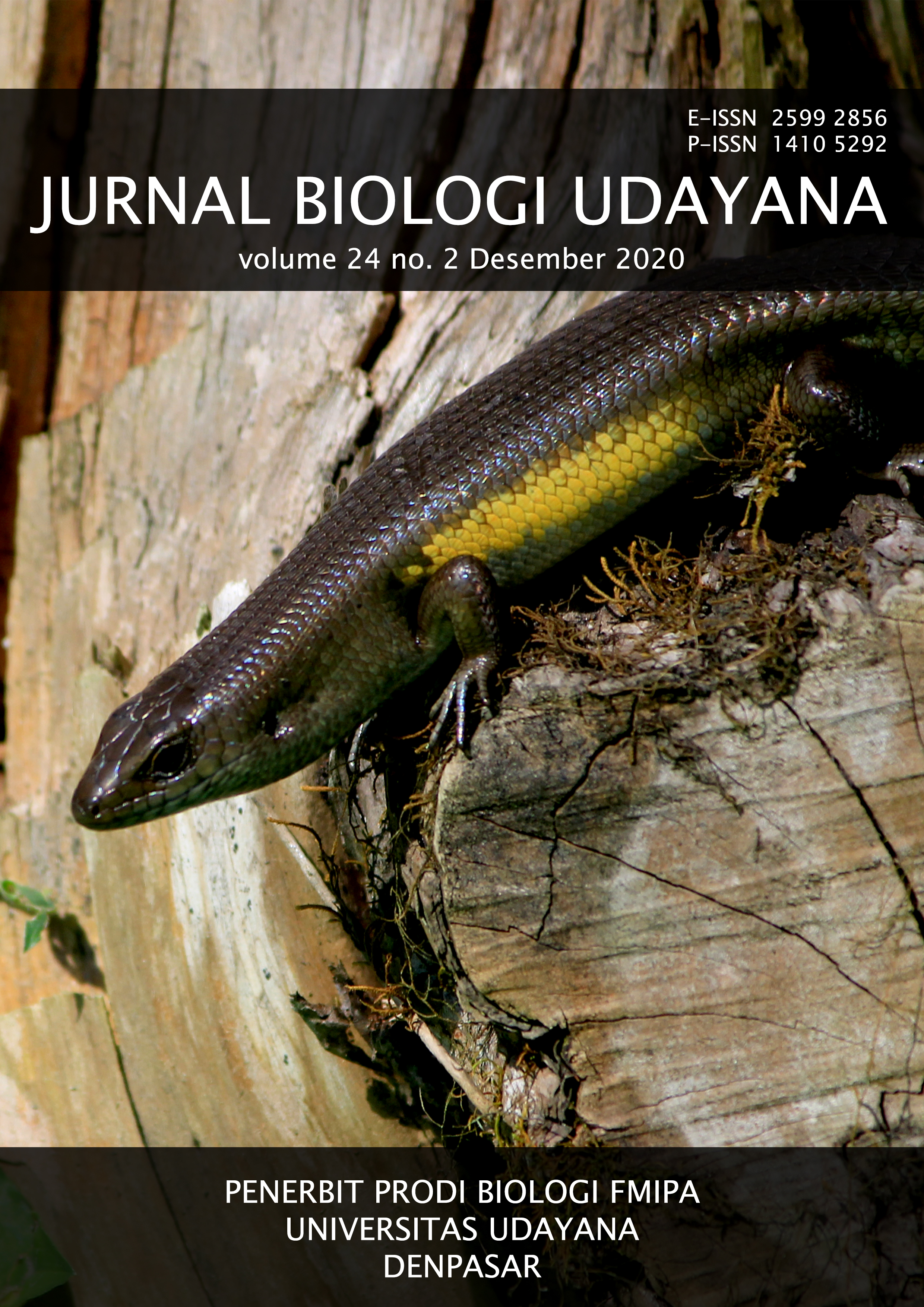Potensi Bacillus cereus dalam produksi biosurfaktan
Abstract
Biosurfactants from microorganisms have stable physical and chemical properties, environment friendly, biodegradable, renewable, cheaper and low toxicity that can be used in the pharmaceutical industry as antibacterial. The aim of this study was to examine the emulsification and characterization of biosurfactant from Bacillus cereus. Hemolysis and spreading oil tests was performed as an initial screening. Biosurfactant production was carried out by growing bacteria on oil-enriched media with shaker system for 7 days. The supernatant was measured for biosurfactant activity through an emulsification index and characterized using thin layer chromatography and antibacterial qualitative testing. The emulsification index on days 0, 1, 3, 5, and 7 showed percentage in sequence 44,83%, 48,28%, 51,72%, 46,43%, and 51,50%. The formation of red stains on TLC plates with ninhydrin appearance showed lipopeptide groups. Antibacterial testing using Escherichia coli and Staphylococcus aureus showed the formation of clear zones around the disk paper. Bacillus cereus can produce biosurfactants of the lipopeptide group with the largest emulsification index of 51.72% and has antibacterial activity against both gram positive and gram negative.
Downloads
References
Bottone, E.J., 2010. Bacillus cereus, a Volatile Human Pathogen. Clinical Microbiology Reviews 23 No. 2, 382–398.
Ciccyliona, D.Y., Nawfa, R., 2012. Pengaruh pH Terhadap Produksi Biosurfaktan oleh Bakteri Pseudomonas aeruginosa Lokal. J. Sains Dan Seni Pomits 1, 1-6.
Das P, Mukherjee S, Sen R. 2008. Antimicrobial potential of a lipopeptide biosurfactant derived from a marine Bacillus circulans. J Appl Microbiol 104: 1675-1684.
Das, P., Mukherjee, S., Sen, R., 2009. Substrate Dependent Production of Extracellular Biosurfactant by a Marine Bacterium. Bioresour. Technol. 100: 1015-1019.
Fakruddin, Murad. 2012. Biosurfactant: Production and Application. J Pet Environ Biotechnol 3 (4): 124.
Fatimah. 2007. Uji Produksi Biosurfaktan oleh Pseudomonas sp. Pada Substrat yang Berbeda. Berk. Penel. Hayati (12): 181–185.
Furi, T.A., Coniwanti, P., 2012. Pengaruh Perbedaan Ukuran Partikel dari Ampas Tebu dan Konsentrasi Natrium Bisulfit (NaHSO3) pada Proses Pembuatan Surfaktan. J. Tek. Kim. 18.
Gozan, M., Fatimah, I.N., Nanda, C., Haris, A., 2014. Produksi Biosurfaktan oleh Pseudomonas aeruginosa dengan Substrat Limbah Biodiesel Terozonasi untuk Peningkatan. War. Ind. Has. Pertan. 31, 39–44.
Högfors-Rönnholm, E., Wiklund, T., 2010. Hemolytic Activity in Flavobacterium psychrophilum Is A Contact-Dependent, Two-Step Mechanism and Differently Expressed in Smooth And Rough Phenotypes. Microb. Pathog. 49, 369–375.
Kurniati, T.H., 2016. Bakteri Penghasil Biosurfaktan dari Lingkungan Tercemar Limbah Minyak dan Potensinya dalam Mendegradasi Hidrokarbon Aromatik Polisiklik (HAP). Skripsi. Institut Pertanian Bogor, Bogor.
Purnomohadi, A., 2010. Potensi Antibakteri dan Analisis Emulsifikasi Biosurfaktan dari Isolat Bakteri Lokal - Pusat Penelitian Bioteknologi-LIPI. Institut Pertanian Bogor, Bogor.
Mukherjee S, Das P, Sen R. 2006. Towards commercial production of microbial surfactants. Trends Biotechnol 24: 509-515.
Riffiani, R., Sulistianah, N., 2016. Preliminary Screening Of Biosurfactant Producing Microorganisms Isolated Waigeo Districts Raja Ampat Papua. Prosiding Seminar Nasional II, 26 Maret 2016 : 740-747.
Sandeep, Lahiry dan Rajasree, Sinha. 2017. Biosurfactant : Pharmaceutical Perspective. J Anal Pharm Res 4(3): 00105.
Sari, M., Afiati, F., Kusharyoto, W., 2015. Potency of Oil Sludge Bacteria as a Producer of Biosurfactant and Antimicrobial Agents. Pros. Semin. Nas. Masy. Biodiversitas Indones. 1(1): 85-88.
Singh A, Van Hanne JD, Ward OP. 2007. Surfactants in microbiology and biotechnology: Part 2. Application aspects. Biotechnol Adv 25: 99-121.
Techaoei, S., Lumyong, S., Prathumpai, W., Santiarwarn, D. and Leelapornpisid, P. 2011. Screening characterization and stability of biosurfactant produced by Pseudomonas aeruginosa SCMU106 isolated from soil in Northern
Thailand. Asian Journal of Biological Sciences 4(4): 340-351.
Thavasi, R., Sharma, S., Jayalakshmi, S., 2011. Evaluation of Screening Methods for the Isolation of Biosurfactant Producing Marine Bacteria. J Pet Env. Biotechnol.
Utami, D.S., Priyani, N., Erman, M., 2013. Isolasi dan Uji Potensi Bakteri Tanah Pertanian Berastagi Sumatera Utara dalam Mendegradasi Fungisida Antracol Berbahan Aktif Propineb. Saintia Biologi Vol.1(2) : 1-7.
Walter, Vanessa, Syldatk, Christoph, dan Hausmann, Rudolf. 2010. Biosurfactants : Screening Concepts for the Isolation of Biosurfactant Producing Microorganisms (Edited : Ramkrishna). Landes Bioscience and Springer Science. p. 1-13.





